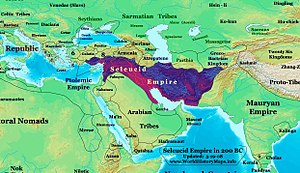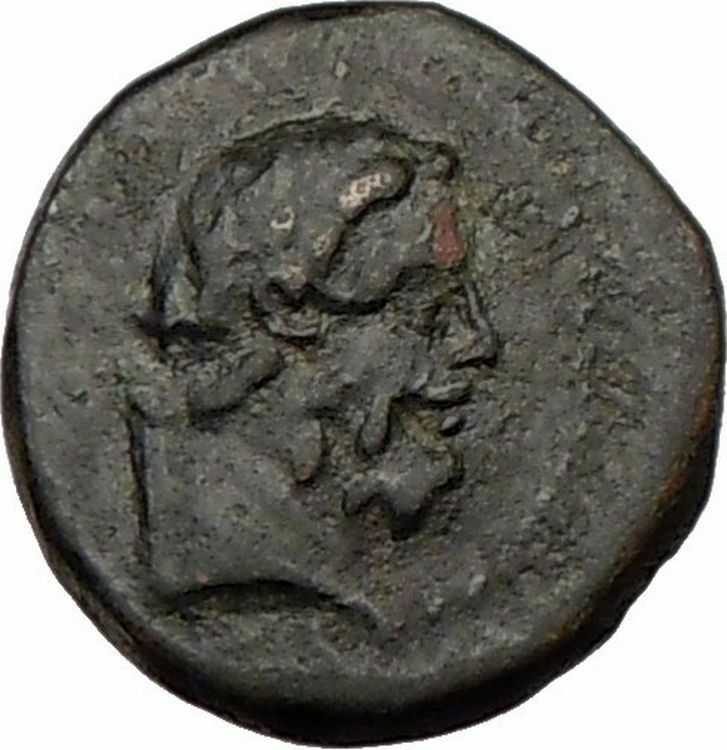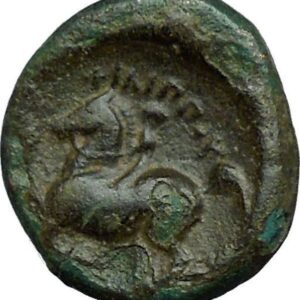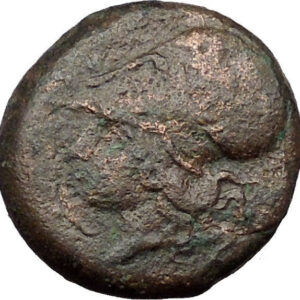|
Seleukid Empire
Antiochos III, Megas – King: 222-187 B.C.
Bronze 10mm (1.22 grams) Struck circa 222-187 B.C.
Reference: HGC 9, 562
Laureate head of Antiochos as Apollo.
ΒΑΣΙΛΕΩΣ ANTIOXOY, Apollo standing left, holding arrow and grounded bow.
You are bidding on the exact item pictured,
provided with a Certificate of Authenticity and Lifetime Guarantee of
Authenticity.
The bow and arrow is a projectile
weapon
system (a bow with
arrows
) that predates
recorded history
and is common to most
cultures
.
Archery
is the art, practice, or skill of
applying it.

Description
A bow is a flexible arc which shoots aerodynamic projectiles called
arrows
. A string joins the two ends of the bow
and when the string is drawn back, the ends of the bow are flexed. When the
string is released, the potential energy of the flexed stick is transformed into
the velocity of the arrow.
Archery
is the art or sport of shooting arrows
from bows.
Today, bows and arrows are used primarily for
hunting
and for the sport of
archery
. Though they are still occasionally
used as weapons of war
, the development of
gunpowder
and
muskets
, and the growing size of armies, led to
their replacement in warfare several centuries ago in much of the world.
Someone who makes bows is known as a
bowyer
, and one who makes arrows is a
fletcher
—or in the case of the manufacture of
metal arrow heads, an arrow smith.
History

Scythians
shooting with bows,
Panticapeum
(known today as
Kertch
,
Ukraine
), 4th century BCE.
The bow and arrow is among the oldest composite projectile weapons invented;
only
spear throwers
and
darts
may predate it, having been in use since
30,000 BCE, with the oldest example from 17,500 BCE. However, despite its
ancient provenance, a number of cultures in historical times lacked the bow and
arrow, and in others
oral history
records a time before its
acquisition.
The earliest potential arrow heads date from about 64,000 years ago in the
South African
Sibudu Cave
, though their identification as
arrowheads (as opposed to
spear
or
dart
heads) is uncertain. The first actual bow
fragments are the Stellmoor bows from northern Germany. They were dated to about
8,000 BCE but were destroyed in
Hamburg
during the Second World War, before
carbon 14 dating
was available; their age is
attributed by archaeological association. The oldest bows in one piece are the
elm
Holmegaard bows
from
Denmark
which were dated to 9,000 BCE. High
performance wooden bows are currently made following the Holmegaard design.
The bow and arrow are still used in tribal warfare in
Africa
to this day. An example was documented
in 2009 in Kenya
when the
Kisii-tribe
and
Kalenjin-tribe
clashed resulting in four
deaths.
Construction

Polychrome small-scale model of the archer XI of the west pediment
of the
Temple of Aphaea
, ca. 505–500 BCE.
Parts of the bow
The basic elements of a bow are a pair of curved
elastic
limbs
, traditionally made from
wood, joined by a riser. Both ends of the limbs are connected by a
string known as the
bow string
. By pulling the string backwards the
archer
exerts
compressive force
on the string-facing section,
or
belly
, of the limbs as well as placing the
outer section, or
back
, under
tension
. While the string is held, this stores
the energy later released in putting the arrow to flight.[citation
needed] The force required to hold the string
stationary at full draw is often used to express the power of a bow, and is
known as its draw weight, or weight. Other things being equal, a higher draw
weight means a more powerful bow, which is able to project arrows heavier,
faster, or a greater distance.
The various parts of the bow can be subdivided into further sections. The
topmost limb is known as the upper limb, while the bottom limb is the lower
limb. At the tip of each limb is a nock, which is used to attach the bowstring
to the limbs. The riser is usually divided into the grip, which is held by the
archer, as well as the arrow rest and the bow window. The arrow rest is a small
ledge or extension above the grip which the arrow rests upon while being aimed.
The bow window is that part of the riser above the grip, which contains the
arrow rest.
In bows drawn and held by hand, the maximum draw weight is determined by the
strength of the archer. The maximum distance the string could be displaced and
thus the longest arrow that could be loosed from it, a bow’s draw length, is
determined by the size of the archer.
A composite bow
uses a combination of materials
to create the limbs, allowing the use of materials specialized for the different
functions of a bow limb. The classic composite bow uses wood for lightness and
dimensional stability in the core, horn to store energy in compression, and
sinew
for its ability to store energy in
tension. Such bows, typically Asian, would often use a stiff end on the limb
end, having the effect of a recurve.[16]
In this type of bow, this is known by the Arabic name ‘siyah’.
Modern construction materials for bows include
laminated
wood,
fiberglass
,
metals
, and
carbon fiber
components.
Arrows
An arrow usually consists of a shaft with an arrowhead attached to the front
end, with fletchings and a nock at the other. Modern arrows are usually made
from carbon fibre, aluminum, fiberglass, and wood shafts. Carbon shafts have the
advantage that they do not bend or warp, but they can often be too light weight
to shoot from some bows and are expensive. Aluminum shafts are less expensive
than carbon shafts, but they can bend and warp from use. Wood shafts are the
least expensive option but often will not be identical in weight and size to
each other and break more often than the other types of shafts. Arrow sizes vary
greatly across cultures and range from very short ones that require the use of
special equipment to be shot to ones in use in the
Amazon River
jungles that are 8.5 feet (2.6
metres) long. Most modern arrows are 22 inches (56 cm) to 30 inches (76 cm) in
length.
Arrows come in many types, among which are breasted, bob-tailed, barrelled,
clout, and target. A breasted arrow is thickest at the area right behind the
fletchings, and tapers towards the nock and head. A bob-tailed arrow is thickest
right behind the head, and tapers to the nock. A barrelled arrow is thickest in
the centre of the arrow. Target arrows are those arrows used for target shooting
rather than warfare or hunting, and usually have simple arrowheads.
Arrowheads
The end of the arrow that is designed to hit the target is called the
arrowhead. Usually, these are separate items that are attached to the arrow
shaft by either tangs or sockets. Materials used in the past for arrowheads
include flint, bone, horn, or metal. Most modern arrowheads are made of steel,
but wood and other traditional materials are still used occasionally. A number
of different types of arrowheads are known, with the most common being
bodkins
, broadheads, and piles. Bodkin heads
are simple spikes made of metal of various shapes, designed to pierce armour. A
broadhead arrowhead is usually triangular or leaf-shaped and has a sharpened
edge or edges. Broadheads are commonly used for hunting. A pile arrowhead is a
simple metal cone, either sharpened to a point or somewhat blunt, that is used
mainly for target shooting. A pile head is the same diameter as the arrow shaft
and is usually just fitted over the tip of the arrow. Other heads are known,
including the blunt head, which is flat at the end and is used for hunting small
game or birds, and is designed to not pierce the target nor embed itself in
trees or other objects and make recovery difficult. Another type of arrowhead is
a barbed head, usually used in warfare or hunting.
Bowstrings
Bowstrings may have a nocking point marked on them, which serves to mark
where the arrow is fitted to the bowstring before firing. The area around the
nocking point is usually bound with thread to protect the area around the
nocking point from wear by the archer’s hands. This section is called the
serving. At one end of the bowstring a loop is formed, which is permanent. The
other end of the bowstring also has a loop, but this is not permanently formed
into the bowstring but is constructed by tying a knot into the string to form a
loop. Traditionally this knot is known as the archer’s knot, but is a form of
the timber hitch
. The knot can be adjusted to
lengthen or shorten the bowstring. The adjustable loop is known as the “tail”.
Bowstrings have been constructed of many materials throughout history,
including fibres such as
flax, silk
, and
hemp. Other materials used were animal
guts
, animal
sinews
, and
rawhide
. Modern fibres such as
Dacron
or
Kevlar
are now used in bowstring construction,
as well as steel wires in some compound bows.
Compound bows
have a mechanical system of
pulley cams over which the bowstring is wound.
Types of bows
There is no one accepted system of classification of bows. Some systems
classify bows as either longbows or composite bows. In this system, a longbow is
any bow that is made from one material. Composite bows are made from two or more
layers of different materials. Other classifications divide bows into three
types — simple, backed, and composite. In this scheme, simple bows are made of
one material, backed bows are made of two layers, which could be similar or
different materials. Composite bows are made of three different layers, usually
different materials, but occasionally two of the layers are made from the same
material.
Common types of bow include
-
Recurve bow
: a bow with the tips curving
away from the archer. The curves straighten out as the bow is drawn and the
return of the tip to its curved state after release of the arrow adds extra
velocity to the arrow.
-
Reflex bow
: a bow that curves completely
away from the archer when unstrung. The curves are opposite to the direction
in which the bow flexes while drawn.
- Self bow
: a bow made from one piece of
wood.
- Longbow
: a self bow that is usually quite
long, often over 5 feet (1.5 metres) long. The traditional
English longbow
was usually made of
yew
wood, but other woods are used also.
-
Composite bow
: a bow made of more than one
material
-
Compound
: a bow with mechanical aids to
help with drawing the bowstring. Usually, these aids are pulleys at the tips
of the limbs.
Crossbow
In a crossbow
, the limbs of the bow, called a
prod, are attached at right angles to a crosspiece or
stock
in order to allow for mechanical pulling
and holding of the string. The mechanism that holds the drawn string has a
release or trigger that allows the string to be released. A crossbow shoots a
“bolt” rather than an arrow.

In
Greek
and
Roman mythology
,
Apollo, is one of the most
important and diverse of the
Olympian deities
. The ideal of the
kouros
(a beardless youth), Apollo has been
variously recognized as a god of light and the sun; truth and prophecy;
archery
; medicine and healing; music, poetry,
and the arts; and more. Apollo is the son of
Zeus and Leto
, and has a
twin
sister, the chaste huntress
Artemis
. Apollo is known in Greek-influenced
Etruscan mythology
as Apulu. Apollo was
worshiped in both
ancient Greek
and
Roman religion
, as well as in the modern
Greco
–Roman
Neopaganism
.
As the patron of Delphi
(Pythian Apollo), Apollo was an
oracular
god — the prophetic deity of the
Delphic Oracle
. Medicine and healing were
associated with Apollo, whether through the god himself or mediated through his
son Asclepius
, yet Apollo was also seen as a god
who could bring ill-health and deadly
plague
as well as one who had the ability to
cure. Amongst the god’s custodial charges, Apollo became associated with
dominion over
colonists
, and as the patron defender of herds
and flocks. As the leader of the
Muses (Apollon Musagetes) and director of their choir, Apollo
functioned as the patron god of music and
poetry
.
Hermes
created the
lyre for him, and the instrument became a common
attribute
of Apollo. Hymns sung to Apollo were
called paeans
.
In Hellenistic times, especially during the third century BCE, as Apollo
Helios he became identified among Greeks with
Helios
,
god of the sun
, and his sister Artemis
similarly equated with
Selene
,
goddess of the moon
. In Latin texts, on the
other hand, Joseph Fontenrose declared himself unable to find any conflation of
Apollo with
Sol
among the
Augustan poets
of the first century, not even
in the conjurations of
Aeneas
and
Latinus
in
Aeneid
XII (161–215). Apollo and Helios/Sol
remained separate beings in literary and mythological texts until the third
century CE.
Antiochus III the Great, (Greek
Ἀντίoχoς Μέγας; ca. 241–187 BC,
ruled 222–187 BC), younger son of
Seleucus II Callinicus
, became the 6th ruler of the
Seleucid Empire
as a youth of about eighteen in 223 BC. Ascending the throne
at young age, Antiochus was an ambitious ruler. Although his early attempts in
war against the
Ptolemaic Kingdom
were unsuccessful, in the following years of conquest
Antiochus proved himself as the most successful Seleucid King after
Seleucus I
himself. His traditional designation, the Great, reflects
an epithet he briefly assumed after his Eastern Campaign (it appears in regnal
formulas at Amyzon in 203 and 202 BC, but not later). Antiochos also assumed the
title “Basileus Megas” (which is
Greek
for Great King), the
traditional title of
the Persian kings, which he adopted after his conquest of Koile Seleukia.
//
Early years
Antiochus III inherited a disorganized state. Not only had
Asia Minor
become detached, but the farther eastern provinces had broken away,
Bactria
under
the Greek
Diodotus of Bactria
, and
Parthia
under
the nomad chieftain
Arsaces
. Soon after Antiochus’s accession,
Media
and
Persis
revolted under their governors, the brothers
Molon
and
Alexander
.
The young king, under the baneful influence of the minister
Hermeias
,
authorised an attack on
Judea
instead of
going in person to face the rebels. The attack on Judea proved a fiasco, and the
generals sent against Molon and Alexander met with disaster. Only in Asia Minor,
where the king’s cousin, the able
Achaeus
represented the Seleucid cause, did its prestige recover, driving
the Pergamene power back to its earlier limits.
In 221 BC Antiochus at last went east, and the rebellion of Molon and
Alexander collapsed. The submission of Lesser Media, which had asserted its
independence under
Artabazanes
, followed. Antiochus rid himself of Hermeias by assassination
and returned to Seleukia
(220 BC). Meanwhile Achaeus himself had revolted and assumed the title of king
in Asia Minor. Since, however, his power was not well enough grounded to allow
of his attacking Seleukia, Antiochus considered that he might leave Achaeus for the
present and renew his attempt on Judea.
The campaigns of 219 BC and 218 BC carried the Seleucid armies almost to the
confines of
Ptolemaic Egypt
, but in 217 BC
Ptolemy IV
confronted Antiochus at the
battle of Raphia
and inflicted a defeat upon him which nullified all
Antiochus’s successes and compelled him to withdraw north of the
Lebanon
. In
216 BC Antiochus went north to deal with Achaeus, and had by 214 BC driven him
from the field into Sardis
. Antiochus contrived to get possession of the person of
Achaeus
(see
Polybius
),
but the citadel held out until 213 BC under Achaeus’ widow
Laodice
and then surrendered.
Having thus recovered the central part of Asia Minor – for the Seleucid
government had perforce to tolerate the dynasties in
Pergamon
,
Bithynia
and Cappadocia
– Antiochus turned to recover the outlying provinces of the north
and east. He obliged
Xerxes of Armenia
to acknowledge his supremacy in 212 BC. In 209 BC
Antiochus invaded Parthia
, occupied the capital
Hecatompylus
and pushed forward into
Hyrcania
.
The Parthian king
Arsaces II
apparently successfully sued for peace.
Bactrian
campaign and Indian expedition
Year 209 BC saw Antiochus in
Bactria
,
where the
Greco-Bactrian
king
Euthydemus I
had supplanted the original rebel. Antiochus again met with
success.
After sustaining a famous siege in his capital
Bactra
(Balkh), Euthydemus obtained an honourable peace by which
Antiochus promised Euthydemus’ son
Demetrius
the hand of one of his daughters.
Antiochus next, following in the steps of Alexander, crossed into the
Kabul
valley,
renewed his friendship with the
Indian
king
Sophagasenus
and returned west by way of
Seistan
and Kerman (206/5). According to
Polybius
:
-
“He crossed the Caucasus (Hindu
Kush) and descended into India; renewed his friendship with
Sophagasenus
(Subhashsena in Prakrit) the king of the Indians; received
more elephants, until he had a hundred and fifty altogether; and having once
more provisioned his troops, set out again personally with his army: leaving
Androsthenes of Cyzicus the duty of taking home the treasure which this king
had agreed to hand over to him.”
Polybius 11.39
Persia and Koile
Seleukia campaigns

The Seleucid Empire in 200BC, (before Antiochus was defeated by the
Romans)..
From
Seleucia on the Tigris
he led a short expedition down the
Persian
Gulf
against the
Gerrhaeans
of
the Arabian coast (205 BC/204 BC). Antiochus seemed to have restored the
Seleucid empire in the east, and the achievement brought him the title of “the
Great.” (Antiochos Megas). In 205 BC/204 BC the infant
Ptolemy V Epiphanes
succeeded to the Egyptian throne, and Antiochus is said
(notably by Polybios) to have concluded a secret pact with
Philip V of Macedon
for the partition of the Ptolemaic possessions. Under
the terms of this pact,
Macedon
were to receive Egypt’s around the Aegean Sea and
Cyrene
while Antiochus would take
Cyprus
and
Egypt.
Once more Antiochus attacked the Ptolemaic province of Koile Seleukia and
Phoenicia, and by 199 BC he seems to have had possession of it before the
Aetolian,
Scopas
, recovered it for Ptolemy. But that recovery proved brief, for in 198
BC Antiochus defeated Scopas at the
Battle of Panium
, near the sources of the
Jordan
,
a battle which marks the end of Ptolemaic rule in Judea.
War against Rome
|
[show]
|
| |
Thermopylae
–
Eurymedon
–
Myonessus
–
Magnesia
|
|
Antiochus then moved to Asia Minor to secure the coast towns which had
belonged to the Ptolemaic overseas dominions and the independent Greek cities.
This enterprise brought him into antagonism with
Rome
, since Smyrna
and
Lampsacus
appealed to the republic of the west, and the tension became greater after
Antiochus had in 196 BC established a footing in
Thrace
. The
evacuation of Greece by the Romans gave Antiochus his opportunity, and he now
had the fugitive
Hannibal
at
his court to urge him on.
Aetolians. In
191 BC, however, the Romans under
Manius Acilius Glabrio
routed him at
Thermopylae
and obliged him to withdraw to Asia. The Romans followed up
their success by attacking Antiochus in
Anatolia
,
and the decisive victory of
Scipio Asiaticus
at
Magnesia ad Sipylum
(190 BC), following the defeat of Hannibal at sea off
Side, delivered
Asia Minor into their hands.
By the
Treaty of Apamea
(188 BC) the Seleucid king abandoned all the country north
of the
Taurus
, which Rome distributed amongst its friends. As a consequence of this
blow to the Seleucid power, the outlying provinces of the empire, recovered by
Antiochus, reasserted their independence.
Antiochus mounted a fresh expedition to the east in
Luristan
, where he died in an attempt to rob a temple at Elymaïs, Persia, in
187 BC. The Seleucid kingdom as Antiochus left it fell to his son,
Seleucus IV Philopator
, by his wife
Laodice
.
|
Born:
241 BC
Died: |
|
Regnal titles |
| Preceded by
Seleucus III Ceraunus
|
Seleucid King
223–187 BC |
Succeeded by
Seleucus IV Philopator
|
Seleucid
Empire
Σελεύκεια
Seleúkeia |

|
312 BC–63 BC |
↓
|
|
|
The Seleucid Empire in 301 BC.
|
The Seleucid Empire
was a
Hellenistic
state ruled by the Seleucid dynasty
founded by
Seleucus I Nicator
following the division of
the empire created by
Alexander the Great
. Seleucus received
Babylonia
and, from there, expanded his
dominions to include much of Alexander’s
near eastern
territories. At the height of its
power, it included central
Anatolia
, the
Levant
,
Mesopotamia
,
Kuwait
,
Persia
,
Afghanistan
,
Turkmenistan
, and northwest parts of
India
.
The Seleucid Empire was a major center of
Hellenistic
culture that maintained the
preeminence of
Greek
customs where a Greek-Macedonian
political elite dominated, mostly in the urban areas. The Greek population of
the cities who formed the dominant elite were reinforced by emigration from
Greece
. Seleucid expansion into
Anatolia
and Greece was abruptly halted after
decisive defeats
at the hands of the
Roman army
. Their attempts to defeat their old
enemy
Ptolemaic Egypt
were frustrated by Roman
demands. Much of the eastern part of the empire was conquered by the
Parthians
under
Mithridates I of Parthia
in the mid-2nd century
BC, yet the Seleucid kings continued to rule a
rump state
from
the Seleukid Kingdom
until the invasion by
Armenian
king
Tigranes the Great
and their ultimate overthrow
by the Roman
general
Pompey
.
|














